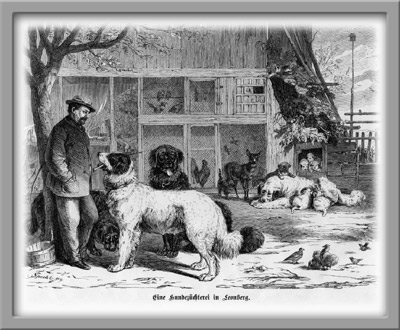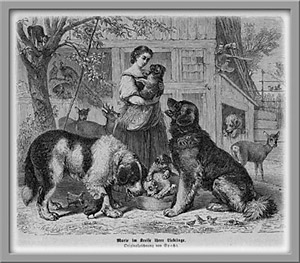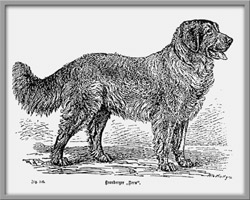Leonberger Breed
Leonberger Breed History

Despite the mythology and often-recited, “rose-colored” version
of the origins of the Leonberger, the early history of the breed is actually
quite clouded and tumultuous. The Leonberger emerged from the enthusiasms
and exploits of Heinrich Essig (1809-1889), a successful politician
with a genius for marketing and public relations. An alderman and a prominent
citizen in Leonberg, Germany, Essig made a successful living as a professional
animal trader who bought and sold dogs for a span of fifty years, trading
sometimes 20 0
to 300 dogs a year at the height of his career.
0
to 300 dogs a year at the height of his career.
Essig’s strong suit was vision and marketing communications, not attention to the details of dog breeding! So, it was “chutzpah” rather than verifiable breeding records that led him in 1846 to declare the “creation” of the Leonberger. Whether Essig actually created a new breed by careful selection following genetically sound principles is rather doubtful. What we do know for certain is that Essig’s marketing genius resulted in such widespread popularization of the breed, that the Leonberger, as a breed, survived cries of outrage from breeders of Saint Bernards and Newfoundlands, from judges, and from the editors of dog magazines such as Der Hund. At the same time, Essig had ardent loyalists who paid great sums for his dogs and defended him publicly. Through his marketing skill, Essig’s dogs found their way into the castles of royalty, most notably Empress Elizabeth of Austria, the Prince of Wales, Emperor Napoleon II, Garibaldi, the King of Belgium, Bismarck, King Umberto of Italy, and the Czar of Russia. They were exported as far away as United States, England, Newfoundland and Japan to the wealthy who desired large fashionable dogs.
Essig died in 1889 without ever defining a standard for the breed or a defensible description of his breeding program. It is a tribute to the qualities of the Leonberger that in spite of harsh criticism from the dog fancy establishment, there were enough enthusiastic owners to form, beginning in 1891, the first Leonberger club.

Unfortunately, this first Leonberger club did not survive very long and it was not until 1895 that the “Internationaler Klub für Leonbergerhunde” was founded with Albert Kull as president. Kull was also the author of the first Leonberger Standard. With the eye of an artist he did a good enough job that this standard formed the foundation for all subsequent standards.
World War I almost rendered the breed extinct. However, the determination and dedication of two men, Karl Stadelmann and Otto Josenhans, saved the breed by finding and breeding the foundation stock that formed the basis for the breed as it is known today. By scouring post-war Germany they found 25 dogs that represented their vision of a typical Leonberger, five of them suitable for breeding. Inflation and food forced a breeding cooperative to be formed. Within four years the dedicated members of the cooperative had selectively bred 350 Leonbergers and established the official Breed Registry, which continues uninterrupted today.
Both dogs and accurate records survived the destruction of WWII. After
a few tumultuous years right after the war it was the veterinarian Dr.
Herbstreith that successfully led the club from 1963 until his death
in 1974. Thereafter, Robert Beutelsbacher took over and left
a legacy with his leadership, writing a firm set of breeding regulations
and updated the standard as well as established international cooperation.
In 1975, the German Club brought all the Leonberger breed clubs from
the major European nations together and founded the International Union
of Leonberger Clubs. The Union is comprised of delegates from most of
the National Leonberger Clubs throughout the western world who meet annually
at the German National Leonberger Club Show.
@ Caroline Bliss Isberg